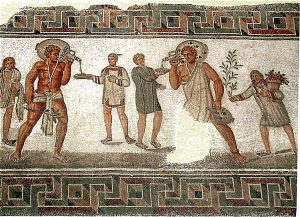Professor Curtis Dozier and Tao Beloney ’23, Greek and Roman Studies Department
This summer I worked with Professor Dozier to study the representations of Ancient Roman slavery in popular high school Latin textbooks and ultimately to create the beginnings of some supplementary materials for teachers covering the subject. This, along with the broader racism in Classics departments and education, is the subject of longstanding activism, and this project exists within that activism.

Dated to he 3rd century CE, this mosaic depicts two slaves carrying wine jugs. Image: Pascal Radigue (Wikimedia Commons)
I began by studying the best practices for teaching American slavery as laid out in the Southern Poverty Law Center’s oft-cited Teaching Hard History report, and proceeded to study the presentation of slavery in three of the most popular high school Latin textbooks, keeping in mind the shortcomings that the SPLC identified in US history textbooks. Considering all this, I studied the up-to-date treatments of ancient Roman slavery, using Peter Hunt’s Ancient Greek and Roman Slavery and volume 1 of the Cambridge World History of Slavery. I then proceeded to sketch the beginnings of some supplementary materials that teachers might use when discussing slavery in Ancient Rome, modelled off of pedagogical priorities outlined in the SPLC’s Hard History framework.
We chose to create supplementary materials because most high school teachers, particularly in public schools, do not choose their textbooks and do not have budgets or time for more materials. Though some reformers support the wholesale rejection of the current textbooks, and some books are perhaps incurably awful, better textbooks will take time and investment from publishers while supplementary materials that can be added to existing materials allow teachers to make changes to their treatments of the subject now. Thus free materials that can be added on top of mandatory subject matter are ideal.
The materials are organized roughly by topic, for example manumission (the practice of freeing slaves) or the slave trade, and are designed to be inserted into lessons or lectures whenever teachers arrive at them. For example, teachers could add to textbook’s treatment of manumission by pointing out how the practice served the interests of enslavers: the possibility of manumission was a method of social control designed to pit enslaved people against each other by encouraging them to compete for their freedom, thus preventing the development of group identity. These resources are a proof of concept that might be expanded upon by others in the future, perhaps to cover Roman slavery more comprehensively or to address other topics like imperialism or gender politics.
